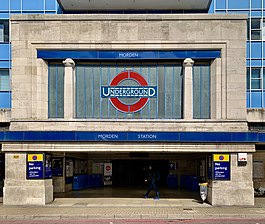
The Northern line is a London Underground line that runs from North London to South London. It is printed in black on the Tube map. The Northern line is unique on the Underground network in having two different routes through central London, two southern branches and two northern branches. Despite its name, it does not serve the northernmost stations on the Underground, though it does serve the southernmost station at Morden, the terminus of one of the two southern branches.
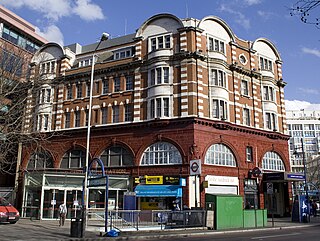
Elephant & Castle is a London Underground station in the London Borough of Southwark in south London. It is on the Bank branch of the Northern line between Borough and Kennington stations. It is also the southern terminus of the Bakerloo line and the next station towards north is Lambeth North. The station is in both Travelcard Zones 1 and 2. The Northern line station was opened in 1890 by the City and South London Railway (C&SLR) while the Bakerloo line station was opened sixteen years later by the Baker Street and Waterloo Railway (BS&WR). There is an out-of-station interchange with the nearby Elephant & Castle National Rail station.

Kennington is a London Underground station on Kennington Park Road in Kennington within the London Borough of Southwark. The station is served by the Northern line and is at the junction of the Charing Cross and Bank branches to the north and the Morden and Battersea Power Station branches to the south. Northbound, the next stations are Waterloo on the Charing Cross branch and Elephant & Castle on the Bank branch. Southbound, the next stations are Oval towards Morden and Nine Elms towards Battersea Power Station respectively. The station is in both Travelcard Zones 1 and 2.

Wimbledon is an interchange station located on Wimbledon Bridge, Wimbledon in London for London Underground, London Trams and National Rail services, and is the only station in London that provides an interchange between the London Underground and Tramlink.

South Wimbledon is a London Underground station in South Wimbledon, a suburb of Wimbledon in south-west London. The station is on the Northern line, situated between Colliers Wood and Morden stations. It is located on the corner of Merton High Street (A238) and Morden Road (A219). South Wimbledon is on the boundary between Travelcard Zone 3 and Zone 4.

The City and South London Railway (C&SLR) was the first successful deep-level underground "tube" railway in the world, and the first major railway to use electric traction. The railway was originally intended for cable-hauled trains, but owing to the bankruptcy of the cable contractor during construction, a system of electric traction using electric locomotives—an experimental technology at the time—was chosen instead.

Tooting Broadway is a London Underground station in Tooting in the London Borough of Wandsworth, South London. The station is on the Northern line, between Tooting Bec and Colliers Wood stations and is in Travelcard Zone 3.
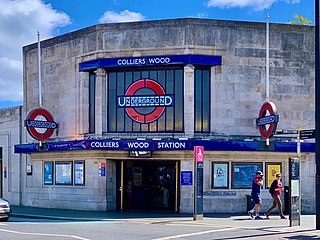
Colliers Wood is a London Underground station in South London. The station is on the Northern line, between Tooting Broadway and South Wimbledon stations. It is located at the corner of Merton High Street (A24) and Christchurch Road. The station is in Travelcard Zone 3.

West Sutton railway station is in the London Borough of Sutton in South London, England. The station is served by Thameslink trains on the Sutton Loop Line. It is in Travelcard Zone 5. It is close to Gander Green Lane, the home ground of Sutton United.
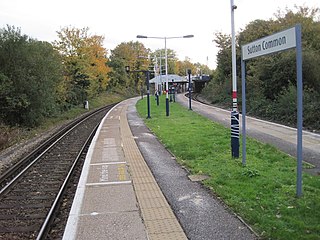
Sutton Common railway station is in Sutton Common in the London Borough of Sutton in South London. The station is served by Thameslink and Southern trains on the Sutton Loop Line. It is in Travelcard Zone 4. It has a single stepped entrance accessible from Sutton Common Road. It is the nearest rail station to the adjoining neighbourhood Benhilton via the footbridge at Angel Hill.

St Helier railway station is in the London Borough of Merton in South London. The station is served by Thameslink, and is on the Sutton Loop Line. It is in Travelcard Zone 4.

Morden South railway station is in Morden in the London Borough of Merton. The station is served by Thameslink trains on the Sutton Loop Line. It is in Travelcard Zone 4.
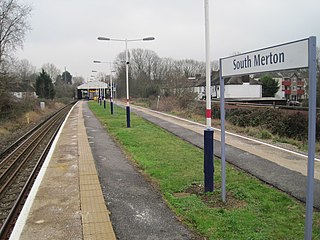
South Merton railway station is located in Morden, the administrative centre of the London Borough of Merton in South London. The station is served by Thameslink trains on the Sutton Loop Line. It is in Travelcard Zone 4.
The Wimbledon and Sutton Railway (W&SR) was a railway company established by an Act of Parliament in 1910 to build a railway line in Surrey from Wimbledon to Sutton via Merton and Morden in the United Kingdom. The railway was promoted by local landowners hoping to increase their land's value through its housing development. It was initially planned that services on the railway would be operated by the London Underground's District Railway (DR) as an extension of its existing service from Wimbledon.

Elm Grove or Tennis Ground was an authorised railway station planned by the Wimbledon and Sutton Railway (W&SR) and Underground Electric Railways Company of London (UERL) but never built. It was to be located near Elm Grove in Wimbledon, in south-west London.

Elm Farm was an authorised railway station planned by the Wimbledon and Sutton Railway (W&SR) and Underground Electric Railways Company of London (UERL) but never built. It was to be located on the western edge of what is now St Helier on the border between the London Boroughs of Merton and Sutton, in south-west London.

Collingwood Road was an authorised railway station planned by the Wimbledon and Sutton Railway (W&SR) and Underground Electric Railways Company of London (UERL) but never built. It was to be located on Collingwood Road in Sutton in south-west London.
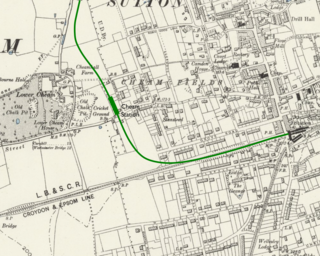
Cheam was an authorised railway station planned by the Wimbledon and Sutton Railway (W&SR) and Underground Electric Railways Company of London (UERL) but never built. It was to be located on Cheam Road in Sutton in south-west London.

Cannon Hill was an authorised railway station planned by the Wimbledon and Sutton Railway (W&SR) and Underground Electric Railways Company of London (UERL) but never built. It was to be located on Cannon Hill Lane in Merton, in south-west London.
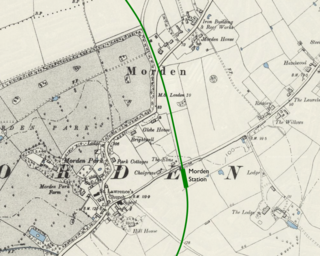
Morden was an authorised railway station planned by the Wimbledon and Sutton Railway (W&SR) and Underground Electric Railways Company of London (UERL) but never built. It was to be located close to the original centre of Morden village in the London Borough of Merton, in south-west London.
